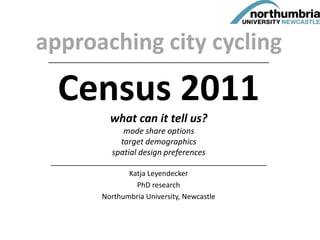Katja Leyendecker Cycle City Newcastle conference 26 June 2015
- 1. approaching city cycling_______________________________________________________________________ Census 2011 what can it tell us? mode share options target demographics spatial design preferences ______________________________________________________ Katja Leyendecker PhD research Northumbria University, Newcastle
- 2. Census 2011 ŌĆó high coverage 19/20 ŌĆó every 10 years ŌĆó tight and only travel question "how do you usually travel to work" ŌĆó main mode, by distance ŌĆó commute / working population only
- 3. Mode share
- 4. Mode share
- 5. Mode share
- 6. Modes by trip lengths
- 7. Modes by trip lengths
- 8. 4% 4% 17% Modes by trip lengths 8% 15% 20%
- 9. 8% 15% 20% Modes by trip lengths
- 10. Modes by trip lengths 8% 15% 20%
- 11. 8% 15% 20% Modes by trip lengths
- 12. Cycle trajectory ŌĆō world cities Women indicate - canaries for cycling environment Source: Pucher & Buehler (2012) Red: Census 2011 overlay
- 13. Cycle trajectory - UK Census 2011
- 14. What do women need? UK women currently excluded through socialisation, gendered lifestyles: ’ā╝ still family-carer ’ā╝ escorting to school ’ā╝ getting the shopping in ’āś short trips ’āś trip-chaining ’āś complex travel diaries
- 15. These trips are cycled by choice in ŌĆó Amsterdam ŌĆó Copenhagen Where cycling infrastructure offers ŌĆō inclusive ŌĆō equitable ŌĆō transport participation ŌĆō comfort ŌĆō convenience ŌĆō (safety and security) Reading material: Eyer, A., & Ferreira, A. (2015). Taking the tyke on a bike: mother's; and childless women's space- time geographies in Amsterdam compared. Environment and Planning A, 47(3), 691-708. doi: 10.1068/a140373p
- 18. Further reading Census Goodman, A. (2013). Walking, cycling and driving to work in the English and Welsh 2011 census: trends, socio-economic patterning and relevance to travel behaviour in general. PLoS ONE, 8(8), e71790. doi: 10.1371/journal.pone.0071790 Aldred, R., Woodcock, J., & Goodman, A. (2015). Does More Cycling Mean More Diversity in Cycling? Transport reviews, 1-17. doi: 10.1080/01441647.2015.1014451 Nested within presentation Garrard, J., Handy, S., & Dill, J. (2012). Women and cycling. In J. Pucher & R. Buehler (Eds.), City cycling: Massachusetts Institute of Technology (MIT). Eyer, A., & Ferreira, A. (2015). Taking the tyke on a bike: mother's; and childless women's space- time geographies in Amsterdam compared. Environment and Planning A, 47(3), 691-708. doi: 10.1068/a140373p
- 19. Thanks for listening Contact Email katja.leyendecker@northumbria.ac.uk Blog https://katsdekker.wordpress.com/ Twitter @katsdekker



















